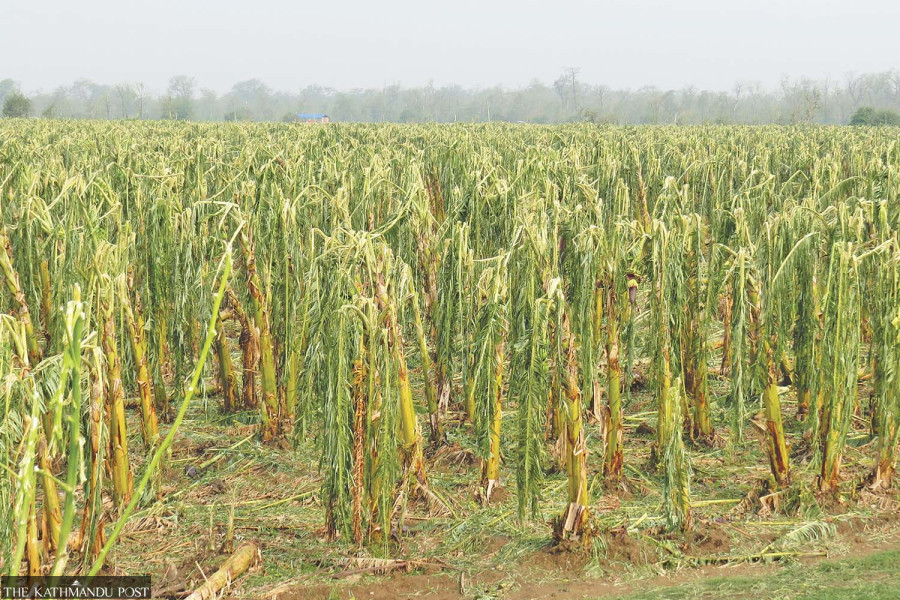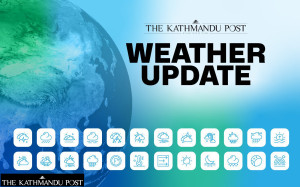Weather
Can better insurance buffer Nepali farmers against climate change?
Experts say yes, but there are problems galore in Nepal’s insurance system, discouraging farmer participation despite almost free crop and livestock insurance schemes.
Sangam Prasain
Every year, adverse weather events such as drought, excessive rainfall, and storms cause huge losses to farmers in Asia and beyond.
This year, South Asian meteorologists have said that most of South Asia, including Nepal, will receive above-normal monsoon rainfall, which is good for Nepal’s rain-fed agriculture system.
But experts say it is also a warning sign. Excessive rainfall brings disaster and may offset economic gains. They say agricultural insurance can protect farmers by covering losses from adverse weather events. This can help farmers maintain their income and continue farming even if a harvest is lost.
“This monsoon, we have projected to witness 35 percent to 55 percent more rains than usual,” said Bharat Mani Pandey, joint secretary at the National Disaster Risk Reduction and Management Authority, during an orientation on insurance and risk finance, jointly organised by the United Nations Development Programme (UNDP) and Society Of Economic Journalists-Nepal.
According to Pandey, the monsoon, which begins in mid-June and ends in early October, may affect 1.8 million people this year.
"We are bringing a disaster management strategy soon to tackle the problems. We are mobilising around 35,000 security personnel in disaster-prone areas as part of our preparedness plan.”
According to Pandey, this year, Gandaki Province will be the most affected area as it may receive 60 percent more rainfall than the usual monsoon rains. “If we prepare early, we can save lives and properties.”
Nepal’s agriculture sector is the mainstay of the country’s economy. It contributes 24.60 percent to the country's GDP and employs over half of the population. The sector is mainly rain-fed and heavily dependent on rainfall.
When there is not enough rain, the GDP tumbles. This dependence makes the country particularly vulnerable to the adverse impacts of climate change.
According to the National Climate Change Survey 2022, the second of its kind, released by the National Statistics Office recently, the economic losses in both farm and off-farm sectors in the last five years, as reported by households, excluding significant infrastructure damages, amounted to Rs415.44 billion.
The survey report said that over the past 25 years, due to climate change, approximately 50 percent of households reported the emergence of new diseases in their crops, 53.9 percent observed the presence of new insects or pests affecting their crops, and 29.8 percent of households noted the appearance of new diseases in their livestock.
Respondents said that drought had been reported as the major disaster, affecting 65.4 percent of households, followed by diseases and insects at 54.3 percent, storms at 46.2 percent, hailstorms at 32.6 percent, floods at 28.5 percent, cold waves at 21.7 percent, landslides at 21.5 percent, and inundation at 17.5 percent.
Experts say that due to extreme climate behaviour, farmers might lose the basis of their livelihoods, and even those who have escaped poverty may be dragged back into it.
Managing risks that affect many people at one time is generally very challenging and costly. Insurance is an important risk management tool, they say.
Pujan Adhikary, director of the insurance development and promotion division of the Nepal Insurance Authority, said that smallholder farmers and rural communities cannot manage climate risks by themselves without adequate financial instruments.
“But insurance is the answer for the extreme weather events and climate change that have increased the risks and uncertainties of farmers and agriculture-based enterprises.”
Agriculture insurance can help promote stability and growth in the industry by reducing the financial risks associated with farming.
But there are problems galore.
Non-life insurance companies have stopped settling claims for insured farm products since mid-March after failing to receive government premium subsidies.
The government is yet to clear around Rs3 billion under this heading to the non-life insurance companies.
“The non-payment issue in the agriculture sector has put us in difficulties. Since companies have totally stopped farm insurance, it will erode the confidence of the farmers towards insurance,” said Adhikary.
Besides non-payment issues, one of the main challenges is to define an appropriate payout rate corresponding to the actual loss experienced by the farmers.
“Lower payout rates than expected will result in a low demand for insurance,” said Adhikary.
She said that careful research and climate risk assessments are essential to design an appropriate weather-based index insurance product rather than relying on the traditional weather-based policy, to meet the demands of farmers.
Nepal has been adopting a weather-based insurance policy.
Experts, however, said that weather-based index insurance could be a powerful tool for stabilising farmers’ income.
Index insurance is a relatively new tool farmers can use to help manage risk. It pays out based on an index, such as rainfall, measured at a local weather station or by satellite, rather than on a consequence of weather, such as a farmer’s crop yield.
Unlike traditional crop insurance, the insurance company does not need to visit a farmer’s field to determine premiums or assess damage. Instead, if the rainfall amount is below a pre-specified threshold, the insurance pays out.
Since the payout is not linked to crop survival or failure, the farmer is always incentivised to make the best decisions for crop survival. This innovation significantly lowers the insurance company’s transaction costs and risks, reducing insurance premiums and increasing accessibility.
Besides, according to Adhikary, they have been working on an ‘inclusive insurance’ policy that covers micro, health and agro sectors broadly.
"We need inclusive insurance which is affordable and accessible. This will cover the low-bracket income people,” said Adhikary.
“We are also studying the possibility of purchasing insurance through mobile phones. The inclusive insurance policy will be simplified to a single page, making it easier for people to understand compared to the current 17-18 pages policy. Claim settlement will also be rapid to build trust among policyholders."
Sabnam Shivakoti, joint secretary at the Ministry of Agriculture and Livestock Development, said farmers are currently discouraged because many of them are unable to receive insurance payouts. “If farmers are affected, it will affect the national food system. So, the issue regarding the non-payment issue should be resolved as soon as possible.”
Crop insurance was introduced in Nepal with much fanfare. The government has been implementing crop and livestock insurance since January 2013 by formulating directives.
Under the scheme, the government provided a 50 percent subsidy on the premium in the first year and raised it to 75 percent in the second year.
The premium subsidy was again reduced to 50 percent and raised to 80 percent in 2021.
According to Shivakoti, when the insurance scheme started ten years ago, there were 802 claims. In the last fiscal year, the annual claims reached 36,000. According to her, of the total agricultural insurance, crop insurance accounts for just 5 percent, while 95 percent is livestock insurance.
“The agriculture sector is a highly risk-prone sector, and agricultural insurance is the key option to manage farm-level risk induced by climate and other disasters,” said Shivakoti.
“The compensation demand for the losses of crops and livestock is rising and causing a burden to the state. Insurance is only the way to compensate farmers,” she said.




 13.12°C Kathmandu
13.12°C Kathmandu











